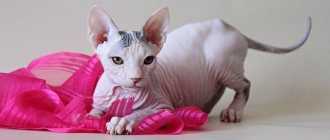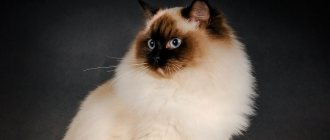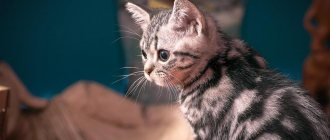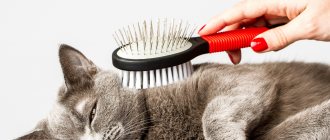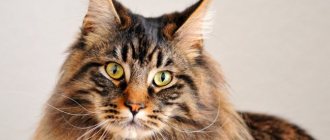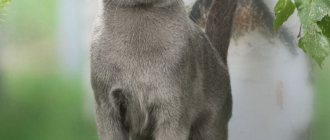Many cats can thrive in an apartment or other small space if you do your part to provide enough attention, play, and environmental enrichment. Some breeds have a laid-back, adaptable nature for small spaces. Cats with low to moderate energy levels also tend to be happy in small living spaces, although active cats may do well if you give them exercise. Here are 10 cat breeds that are suitable for apartments.
Which kitten is better to have in an apartment?
Choosing a kitten for your home is not so easy.
Take into account your preferences and desired character traits. A representative of a passive breed is not suitable for a family with children or for a person who is active by nature. An overly active pet will be difficult to keep in an apartment. Cats shed periodically, and this fact is also taken into account if there are health problems. We recommend paying attention to the following cat breeds:
- Domestic cats of the Scottish breed are sensitive to the mood of the owner and do not require much attention. They are ready to play and are joyfully greeted from work, but do not bother if the owner is not in the mood.
- A Burmese kitten is suitable for those who are ready to pay attention to their growing pet. The Burmese has an easygoing disposition, he is affectionate and gentle, and does not require much space to keep.
- The British Shorthair looks like a plush toy and evokes sympathy and affection. The kitten easily adapts to being kept in an apartment, but does not accept very annoying household members.
- The Russian Blue cat impresses with its friendly character and calmness. Does not require excessive attention, we train well.
- For older people, a Javanese cat is suitable. She is affectionate, playful and responsive to her master's requests.
Burmese
The Burmese is generally gentle and pleasant. These are social cats that prefer the constant company of their owners or other pets, so they are not lonely. They are also quite athletic and need cat trees and other places where they can jump and have fun. But as long as they have constant attention, the size of their home doesn't really matter.
instagram
The most unpretentious cats for an apartment
The category of unpretentious pets is usually classified as moderately active, independent, and not requiring special care:
- Burmese cats are distinguished by their elegant appearance and easy-going character. They are easy to care for and obedient.
- The Ragdoll is obedient and affectionate, allowing itself to be stroked. The cat’s disposition fully reflects the name of the breed (“rag doll” translated into Russian), and is suitable for keeping in a family with children.
- Representatives of the American Shorthair breed are endowed with a light character. They get along well with other animals and are in good health.
- Burmillas are short-haired, fluffy cats that are very calm and friendly. They get along easily with people and other four-legged household members.
- The Cornish Rex just needs to be fed, trained and petted to your heart's content.
What selection criteria should you focus on?
The choice of sex of a four-legged pet is influenced by many factors. One of the most important criteria is the type of home in which the owner lives. We must not forget about those who live next to him. The presence of small children and other pets must be taken into account. An important factor will be how the new pet tolerates loneliness and long separation from a loved one.
In an apartment or private house
When thinking about whether it is better to have a cat in an apartment or a country house, you can read forums or chat with experienced owners. Most often, in a city apartment it is recommended to have cats. Females are cleaner than males, do not leave odorous marks, and do not scatter litter. In addition, keeping a girl in a confined space will not result in an unplanned pregnancy, because the owner can control her social circle.
Cats love to spend time on the couch and on a person's lap. They don't need the open spaces of the street to feel happy. But the female, unlike the males, is much more effective in ridding the country house of annoying rodents. Cats quickly lose interest in monotonous hunting and find other activities - mainly guarding the territory and clashes with neighboring cats.
Boys prefer the opportunity to go outside the home. They want to run, jump, climb trees. Males need to feel like masters, so they mark their territory. Finding such marks in an apartment is not very pleasant. A private house will be the optimal habitat for boys.
Affectionateness
The furry pet is very sensitive to the attitude of family members. If someone doesn’t like him or offends him, the two-legged animal avoids him.
Girls are more prone to reciprocal affection and tenderness from the owner. Kitties become more attached to a person and better adapt to his character. Cats are more independent in this regard. They are more interested in climbing a tree or curtain than purring in the arms of their owner.
Intelligence and ease of education
The behavior of mustaches directly depends on their upbringing
It is important to instill in children the norms of behavior in the family from early childhood. Representatives of any gender and breed respond well to the persistent demands of the owner
However, females are more flexible in this regard. They will fulfill a person’s demands, so as not to offend him, to please him.
Males, on the contrary, will prefer to run away, hide, rather than obey. It is more difficult to train them to use the cat litter box and not to throw litter around. After a walk outside, males will immediately jump onto the sofa, and the girl will patiently allow her to wipe her paws.
Independent representatives of the cat family that do not like to obey humans and are difficult to train include the British, Russian Blue, and Scottish Fold breeds. But sphinxes, bobtails, and orientals are ready to do anything for the sake of their owner, so they can be trained without any problems - regardless of their gender.
Are there small children in the family?
Females are much more obedient and affectionate than males. They are less likely to scratch and bite
In a family with a small child, this is very important. The male is accustomed to dominating and defending his position no matter what, so he is capable of harming the baby
You must understand that no animal likes to have its tail pulled, constantly pressed and squeezed. It is necessary to explain to the child that this is not a toy, but a living creature with its own character. Sooner or later, both girls and boys can react equally aggressively to persistent caresses and disrespectful attitudes.
Are there other animals in the family?
Because of their inherent mentality, girls share their territory with other pets much more easily. And the tendency to dominate, characteristic of boys, forces them to show their superiority over the rest of the inhabitants. It is especially difficult for two cats to get along in one place. They constantly fight for leadership, arrange showdowns, and mark their territory.
Even castrated males are unlikely to make friends - most likely, their conflicts will subside, but a strong friendship will not work out. If there is an adult cat in the house, it is not advisable to take a second adult male - it is better to take a female or a very small kitten.
Cats get along with other animals depending on their character, and gender does not have that much influence on this. Even a brutal cat can become an affectionate nanny for a horde of puppies, ferrets and even chicks - if his disposition is completely peaceful.
Calm cat breeds in the apartment
Breeders try to choose a calmer breed of cat for an apartment in order to save themselves from problems.
Take a closer look at these calm cat breeds:
- The Neva Masquerade breed attracts with its gentle disposition, goodwill and moderate activity. The cat loves communicating with people and understands them perfectly.
- Siberian cat. Representatives of this breed have a calm, friendly character and get used to those who feed them. The pet needs to be combed periodically to prevent tangles from forming in the long fur.
- The exotic has a calm disposition and is very trusting of its owner, loves to cuddle and play, but prefers to hide from strangers.
- The Singaporean breed is quite rare. Such a cat will get along with everyone and will surprise everyone with mutual understanding.
- Persian cats are calm and intelligent. The pet develops a devoted attachment to its owner, for which Persians are known as monogamous people. A cat's fluffy fur requires special care.
Housing problem
Active Bengal, Abyssinian and Siamese cats, nimble Kuril and Japanese bobtails, representative Maine Coons and Chausies cannot live in small-sized housing.
These cats require space and a lot of exercise. A small apartment will not confuse representatives of such breeds as:
- British Shorthair.
- Scottish (straight and fold).
- Sphinx (Don, Canadian and St. Petersburg).
- Persian and Neva masquerade.
- Exotic shorthair.
- Russian Blue and Siberian.
- Sacred Burmese and Turkish Angora.
After intense exploration of the world in childhood and adolescence, these cats acquire sedateness and wisdom sufficient to not bother their owners.
Waking up from sleep, they monitor the household, making active body movements as needed: as a rule, in the morning, before going to the toilet, and in the evening, to remind who is the real boss in the house.
Smooth-haired cat breeds for home use
To keep a cat in an apartment with less hair, choose smooth-haired representatives:
- The Balinese cat will be liked by its warm color and silky thick coat without undercoat. Balinese are smart, flexible and obedient.
- A Bengal cat looks like a small leopard. The pet is active, but meek and obedient. Loves games and walks.
- The Devon Rex has fur that resembles astrakhan fur. He loves to spend time lying quietly in his owner's arms and loves being stroked.
- The Bombay cat is nicknamed the charming little panther. Behind the predatory appearance lies an easy-going, unobtrusive nature. She is no stranger to games and “conversations” with her owner.
- The European Shorthair (Celtic) breed is naturally healthy. At home, the Celt remains independent, but is responsive to the owner's affection.
Kurilian Bobtail
Kurilian Bobtail
A distinctive feature of the Kurilian Bobtail is its short, curved tail. The cat is small in size, muscular, with a clear contour of the body. Representatives of the breed can have short or semi-long hair.
Advantages and disadvantages
The cat has a soft character and is an excellent hunter and fisherman. Often brings various trophies into the house.
She becomes strongly attached to her owner and remains faithful to him throughout her life.
They are easy to train, which is why they are often compared to dogs.
Their cat tongue is rich. They not only meow, but also grumble, growl, and mutter.
They love to communicate with people, while making sounds similar to human speech.
Reacts to the commands “fu”, “give it” and “throw it”.
Minor disadvantages include not loving strangers. In front of the owner he will behave sedately, but when left alone as guests he can show aggression.
The cat does not like to sit on hands or laps.
The smartest cat breed in the house
Many purebred cats have a well-developed understanding with humans.
You will find an almost ideal intellectual cat among the following suggested options:
- Siamese cats are inquisitive and smart. The Siamese is sensitive to changes in the owner’s mood, is easy to train, and is able to express a wide range of emotions with sounds and intonation.
- The Canadian Sphynx is able to understand the emotional component of human speech. This pet is friendly to all household members and is able to make friends with other cats and dogs. Loves to play and is trainable.
- The Turkish Angora is a long-haired white cat. He understands his owner well and becomes very attached to him, amenable to training. The Angora is an excellent companion for a lonely person.
- The Oriental cat is endowed with the mental ability to subtly and clearly capture a person’s mood, feel his malaise, and relieve pain with the warmth of his body. Oriental is playful and talkative.
- British cat. The British cat is emotionally restrained, calm and well trained. He can be taught to open the door and turn on the light.
Russian blue
The Russian Blue is very affectionate, but not clingy, and can spend part of the day alone, resting in a sunny place. These cats do not need much space, as they are usually quiet and reserved with moderate energy levels. They love to play with cat toys, but often you will find them perched high up somewhere, overlooking their domain.
instagram
The cleanest cats for indoors
For home keeping, not only the agreeableness of character is important, but also the cleanliness of the pet:
- The Russian Blue cat is carefully groomed, its fur is smooth and clean. A pet accustomed to water will not refuse to bathe.
- The Cornish Rex is a very low shedding breed. The pet's fur feels like velor to the touch.
- Rarely shedding options include the Oriental breed. In addition, the cat does not rush around the apartment.
- The Scottish Fold cat has short and very soft fur. Smart, clean and affectionate.
- The Scottish Fold looks like a Scot. The coat is short and licks well. You can get used to water procedures.
Potential difficulties of living with a cat
1. Cats go to the toilet . Yes, and “in a big way” too. Of course, cats are much more clean than dogs; they cannot go to the toilet due to carelessness or from excess emotions, but cats also happen to shit in the wrong place. There can be many reasons for this, but in this case the point is different - the area of the apartment is small, and the smell of cat excrement is quite pungent. This can cause problems with neighbors or homeowners. Therefore, it is preferable to choose animals that are already tray-trained.
Cat litter and kitten
If you think that cats are easy to train and their instincts themselves will push them in the right direction, you are mistaken. Our editor is the proud owner of two large mongrel cats, one of whom completely refuses to remember that a trash can is the wrong place for his litter box. And even if it is possible to convince him of this today, it is not a fact that tomorrow the situation with the surprise found in the trash bin will not repeat itself.
2. Cats shed . And this is also a problem. Are you ready for your entire apartment to be strewn with cat hair? It will get everywhere: on clothes, in food, on all surfaces. In a small space, especially during periods of seasonal molting, cat hair turns into a real punishment.
Grooming a long-haired white cat
Moreover, some cats periodically develop dandruff, to which you or your family members may be allergic. So, when choosing an animal, you need to remember about the upcoming “war” with its fur, and if this is a problem for you, it is better to choose smooth-haired breeds or sphinxes in general. On the other hand, with proper care, problems with the coat will practically not arise. In any case, it is worth paying attention to this issue.
3. Cat's temperament or character . In some cases, it can also present very unpleasant surprises. If you live in a relatively small apartment, you should choose a furry friend of a breed that has the following characteristics:
- lack of a pronounced instinct for one’s own territory;
- easy perception of loneliness;
- sociability;
- friendliness towards strangers;
- not too high activity.
The last thing is worth explaining - cats with high activity require a lot of space for their games. They physically need to spend their energy somewhere, so they rush around the apartment like mad, turning over various objects, damaging furniture, knocking you off your feet. Such animals need to be in the fresh air, so keeping them in an apartment will be problematic for you.
The most hypoallergenic cats in the apartment
People suffering from allergies should choose a cat with caution.
The following breeds are suitable for allergy sufferers:
- The Oriental Shorthair cat practically does not shed, and its excreta contains minimal amounts of the animal allergy-causing protein Fel D1.
- Cornish Rex. It also rarely causes problems with portability.
- The Javanese breed is bred artificially. The Javanese has a fine, silky coat without undercoat. Due to these qualities, it is classified as a hypoallergenic cat.
- The secretions of the Siberian cat are hypoallergenic. The character of the representative of this breed is flexible, the cat is not annoying and does not get underfoot.
- The Ocicat has short hair that rarely sheds. Follows simple commands and can be trained to walk on a leash.
How to choose the right kitten and why should you choose cubs?
Before getting a pet, of course, it is worth deciding how much living space it will subsequently receive, and how much attention and effort it will require in caring for it. It is important how much the cat’s character can fit into the rhythm of the owner’s life. How much time does he spend at home?
The composition of the family, its way of life, the amount of free time and financial capabilities are of great importance when choosing a cat. In addition, it is necessary to take into account the presence of children and other pets, the tendency of cats to aggression and jealousy.
The conditions of a city apartment are actually different for each family. However, they come down to limited free space, high density of interior items and often the combination of many functional areas. Having a kitten means shifting your priorities somewhat: instead of the usual order and tranquility in the house, you need to be prepared for the fact that his appearance will disrupt the order of things. Both literally and figuratively.
Therefore, for keeping in a limited space, you need to choose calm phlegmatic people, melancholic people, and in extreme cases, sanguine people, and not choleric people. Yes, yes, cats also have their own temperament, and a highly active cat of the Siamese-Oriental group, even if you get him as a very small kitten, will be able to turn the whole apartment upside down in one sitting.
Traditional domestic breeds are considered the best idea for apartment keeping.
The British Shorthair or Persian cat will delight you with its even and balanced character, and it is difficult to imagine it riding on a ledge. The characteristics of these breeds imply a calm and stable psyche of cats.
This also includes all Scots by origin: Scottish and Highland also have an undoubted advantage in easy adaptation and adaptability to an apartment.
Of the exotic breeds, all types of Sphinxes are considered the most “apartmental”. They will fit perfectly into the decor of an apartment, however, they need a person a little more than people from Foggy Albion or Persians.
• Pet's age.
Some people prefer "mutts". These cats did not have noble ancestors in their family or they have mixed roots. And this has its advantages. For example, mestizos have better health than their “blue-blooded” counterparts. This is due to the wider gene pool. Therefore, the risk of genetic diseases is very low.
However, such cats often have an independent character, and their hunting instincts are more pronounced. Adults love to mark territory, and it is not very easy to wean them from this habit.
The “mongrel” has better health
At the same time, purebred cats have predictable habits. They value cleanliness more because breeders select for breeding those individuals that are less prone to marking territory.
An adult cat or a cute baby? This seems like a minor issue, but age is an important factor.
Kitty
As a rule, kittens are taken into the house. It is believed that in childhood the animal gets used to the new environment better.
A cat feeds its cubs with milk until they are three months old. This is important because the baby acquires primary immunity. It is the mother who takes best care of health and knows what her “child” needs. Communication with the parent is also responsible for socialization. An early break with a nursing female is fraught with the following problems for the offspring:
- mental disorders;
- behavioral disorders;
- weak immunity.
The mother accustoms the cubs to unfamiliar food, instills hygiene skills, shows how to use a tray and sharpen their claws.
Temporary immunity is transmitted to the kitten with milk.
Cats are vaccinated at 8 and 12 weeks (booster vaccination). Therefore, after 3 months the body is maximally protected from infections.
Adult cat
Animals older than a year are reluctant to be taken into an apartment due to prejudice. But veterinarians assure: often these are just myths that have no basis in reality.
Table 1. The most common misconceptions of future cat owners.
| Myth | Reality |
| It is easier to train a kitten to the litter box | Adults quickly understand what is wanted from them. And if they are already toilet trained, they will not shit anywhere, with rare exceptions and for “good reasons” (stress, illness, etc.) |
| An adult cat will not accept a new owner | Animals that have experienced cold and hunger appreciate taking care of themselves. Kittens take everything for granted and are spoiled |
| The child needs a kitten | Adult cats are more tolerant of children. Many of them have the talent of a nanny and stoically endure the importunity of children. |
| The owners abandoned the cat because he behaved badly | An animal may be left without owners due to their death, relocation, birth of a child, or other “harmless” reasons. |
| If you take a kitten, it will grow up healthy | This is not a fact due to unformed immunity. Kittens are more prone to serious illnesses and suffer more severely from infections. |
Adult cats are often more comfortable than kittens
People who decided to take such a step believe that it was done correctly. They argue that there are many reasons why a shelter cat will do well in an apartment.
Table 2. Pros and cons of a shelter cat.
| Advantages | Flaws |
|
|
As for communication with curators, this is a temporary phenomenon. As soon as volunteers or shelter workers understand that their pupil is in good hands, they stop disturbing the new owner.
Don't be afraid to adopt a cat from a shelter - this has its advantages
Shelters are also found through social networks - usually such organizations have pages. If you couldn’t find an adoption center in your city, you will definitely find one in a neighboring town.
Those who want to get a cat need to know what difficulties they will have to face, regardless of the breed and gender of the animal. A person who is used to traveling should realize that a cat is a homebody who does not like traveling. Rare pets agree to share the road with their owner and even go to the mountains with them.
You need to be patient in order to instill basic skills in your cat - teach him to go to the litter box and sharpen his claws not on furniture, but on a scratching post. Training requires perseverance from a person; training takes energy and time. If there is no desire to work with your pet in this direction, then soon the house will be a mess.
The cat needs to be taught basic skills - to learn to use the litter box.
Another difficulty awaits those who do not consider the possibility of spaying or neutering their pet. Several times a year you will have to go through the real hassle associated with sexual hunting.
Most cats sleep from morning to evening, especially if their owners spend all day at work and do not play with them during daylight hours. They are nocturnal. Therefore, you need to be prepared for the fact that your pet can disturb your sleep with its nightly activities. These are just some of the inconveniences that you will have to put up with.
Popular hairless cat breeds
List of unusual hairless cats:
- Petersburg Sphinx. This is a green-eyed or blue-eyed cat with a muscular body, proud posture and a long neck. The body of the Peterbald is covered with a soft, suede-like undercoat and 2 mm of hair.
- The Kohana is a cat breed native to Hawaii. A cat's skin resembles a soft, waxy surface and is completely lint-free.
- The Don Sphynx is a hairless cat with an almond-shaped, trusting gaze and extravagant ears. He is distinguished by his flexible character.
- The Canadian Sphynx is characterized by an abundance of folds on its graceful, hairless body. The cat surprises with its huge eyes, reflecting the blue of the sky, and is distinguished by its friendliness and sociability.
- The Bambino is a relatively new breed. Characteristic features are a smooth, hairless body with short legs, large ears and a long narrow tail. The cat's character is good-natured and sociable.
Sphinx
Photo Credit: my destination's beautiful Flickr via Compfight
Despite the fact that the Sphynx breed is quite ancient, modern Sphynxes appeared only in the 20th century. Initially, the breed was not specially bred, and appeared as a result of a natural mutation, but then breeders began to make attempts to repeat the birth of hairless kittens. Since then, the Sphynx breed has become increasingly popular. One thing is obvious: there is no such person who would remain indifferent to him. Anyone who sees the Sphinx begins to feel either incredible sympathy or complete rejection.
Sphynx cats are very active, inquisitive, intelligent and get along well with other pets. The Sphinx's favorite place to stay is the lap of its owner. But he will not impose himself on you if you are not in the mood to communicate with him.
Lifespan: 10 -15 years.
Weight and size: height - 20-25 cm, cat weight - 4-5 kg, cat weight - 3-4 kg.
Care: In terms of care, the Sphynx will require more attention from you than any other breed. It is necessary to bathe your Sphynx every week, otherwise he will start to smell unpleasant and leave greasy marks on the furniture and your clothes. Between baths, you can wipe your Sphynx with wet wipes. In the summer, the Sphynx needs to be protected from sunburn, and in the winter, you will have to wrap it in cat sweaters and overalls. The eyes and ears of sphinxes will also require special attention. They must be wiped once a week with damp cotton pads.
The smallest cat breeds
We present to the attention of lovers of small-sized cats the following dwarf breeds:
- Skif-tay-don is a dwarf breed. An adult cat weighs no more than 1.5 kilograms. The pet has beautiful light-colored fur with black accents on its face, ears, paws and the tip of its tail, and its disposition is playful and inquisitive.
- The Munchkin is a fidget on short legs, with a build similar to a dachshund. Loves to make hiding places with his favorite toys. A cat of this breed weighs no more than 3.5 kilograms.
- Napoleon is a small cat with luxurious thick fur on short legs. Attracts with expressive, captivating eyes. The weight of a cat rarely reaches 4 kg.
- The Lamkin is a breed of small cat with a curly and fluffy coat. The name in Russian translation means “lamb”.
- Kinkaloo belongs to the weight category of 2-3 kilograms. The cat is active and playful, loves walks with her owner.
The smallest cat in the world
Mr. Pibbles can be called the absolute record holder among miniature cats. The length of his body at two years old was only 15 cm (excluding the tail). Weight did not exceed 1.3 kg. Mister Pibbles was born from an ordinary yard cat in America, in the state of Illinois. Has short hair. The color is striped. The tips of the paws are white.
Mister Peebles
Because of his small size, the cat named Mr. Pibbles was included in the Guinness Book of Records. Also today a favorite on the Internet. On the Internet you can find photographs in which the cat is completely placed in a glass.
Mr. Pibbles is cheerful, inquisitive, and well-behaved. Its miniature size does not in any way interfere with living a full life. Veterinarians note that Pibbles' small size is due to a genetic disorder.
The fluffiest cats for an apartment
The following furry pets are suitable for keeping in an apartment:
- Angora is a graceful cat with a peaceful disposition.
- Ragamuffin is the owner of a surprisingly luxurious fur coat that requires special care. The cat needs to be bathed and brushed.
- The Persian cat is fluffy and imposing. Requires care.
- The Siberian cat is beautiful and proud of its luxurious tail. The fur is moderately fluffy and does not tangle too much.
- The fur coat of a Kimra cat is comparable to that of a rabbit to the touch. The cat is not a timid cat and is capable of protecting its owner.
Korat
This cat breed is considered one of the oldest. It comes from northern Thailand, from the Korat plateau. Information about blue local cats is contained in the “Cat Book of Poems,” written around the 14th century. The Korat weighs between three and five kilograms. This is a muscular, strong and playful cat. The Korat is known to be incredibly jealous and is not a good pet for small children.
The most original cats for home
If you want to have a pet with an unusual appearance, check out these options:
- The Minskin cat looks like a hobbit. Thick and dense hair covers certain areas of the cat's naked body - the head, ears, paws and tail.
- Dwelf looks like an alien from another planet. A small head with large eyes and ears curved inward, a long, squat body, devoid of hair.
- Mei-kun is a giant among cat breeds. He is good-natured, endowed with soft fluffy hair and cute tassels on his ears.
- The Savannah cat has a leopard coloration. She is large in size, with a good-natured character. Willingly keeps the owner company on a walk.
- The Japanese Bobtail is a cat with an unusual, rabbit-like tail. He is active and intelligent, receptive to training.
British shorthair breed
Photo Credit: marttiratilainen Flickr via Compfight
The breed was finally formed towards the end of the 18th century. The breed is distinguished by its calmness and friendliness, making it perfect for a novice cat owner. This breed is easily recognized by its characteristic rounded muzzle, and their fur feels plush to the touch. If you cannot devote a lot of time to your pet, then this breed will be the ideal choice for you. Thanks to their independence, the British do not require much attention from their owner, and their peaceful nature allows them to get along well in a family where they also have children and other pets. By the way, an interesting feature of this breed is that male cats grow quite slowly; they reach their full size by about 3 years of age.
Lifespan: on average 12.5 years.
Weight and size: 30-35 cm in height, the average weight of a cat is 4-8 kg, a cat is 3-5 kg.
Care: periodic combing and wiping with a damp cloth to remove dead hair.
Cat breeds with good character
The excellent character of a four-legged pet is expressed in such qualities as friendliness and obedience.
A list of cats with wonderful personalities is presented below:
- The Abyssinian cat is distinguished by its balanced disposition and loyalty. She is always ready to give and receive attention.
- Toyger is a medium-sized tabby cat. He has a non-conflict character and gets along easily with his family.
- The Bengal cat not only looks attractive. He has a developed intelligence and a friendly disposition.
- Sacred Burmese cats are obedient and get along well with children and guests.
- Smart and calm Burmese cats are wonderful walking companions and are happy to follow their owner’s commands.
Boy or girl?
When a family decides to adopt a kitten, among other things, the question arises: is a boy better or a girl?
Advantages of cats (females):
- they are cleaner because they take better care of themselves;
- do not seek to dominate;
- more flexible and affectionate.
But with the advent of puberty, the owner has a question: what to do with the offspring? There may be problems with this if the animal was not taken for breeding. Pregnancy is preceded by estrus. The cat leaves marks with a specific musky odor, and for a week or more makes loud noises, especially at night, calling for a male. This ends on its own or after mating with a cat.
Cats like to flirt with their owners
Cats are leaders by nature. They control every step of the inhabitants of the house. Most cats are not affectionate, although sometimes they allow themselves to be picked up and stroked. They become aggressive if a person does something they don't like.
One of the problems that cat owners face is marking their territory. Often, breeders manage to wean their pupils from such behavior. Males smell stronger. But the smell disappears if the animal is properly cared for.
Many problems can be solved by sterilization and castration. But even a castrated male can leave marks. This happens in the following cases:
- late castration;
- the presence of another cat;
- stress, anxiety;
- uneasy situation in the house;
- lack of attention from the owners;
- dirty tray;
- discontent;
- health problems, bladder infections.
Cats show aggression if they don't like something.
